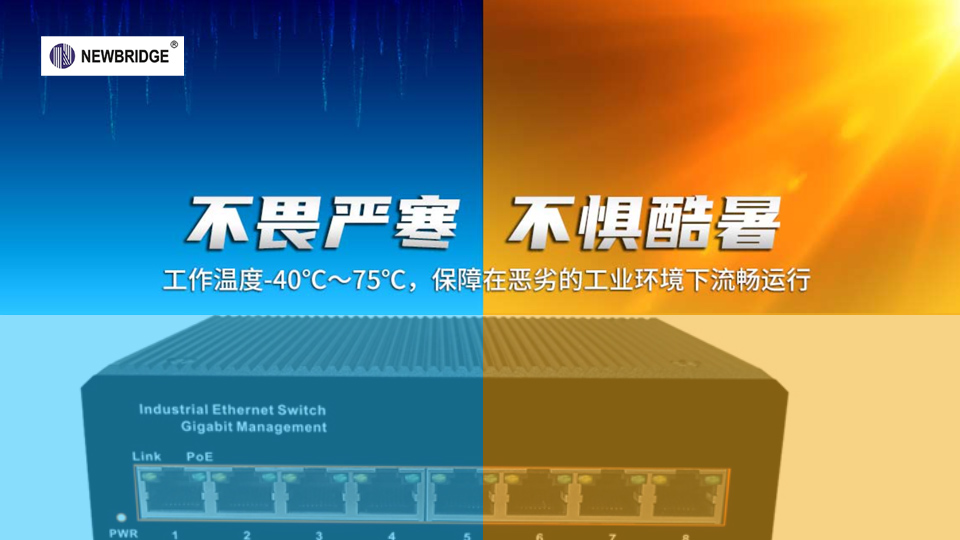Imagine setting up a monitoring system outdoors in the extremely cold north, or deploying network equipment in a hot and humid data center in the south. Industrial switches serve as the "central nervous system" for network transmission, and if they "go on strike" due to temperature issues, the entire system will be paralyzed. So, verifying the true wide temperature performance of industrial switches is like giving them a comprehensive "health check" to ensure that they can stably "serve" in extreme environments. Next, let's take a look at how to do this' physical examination 'together!

1、 First, look at the "Medical Examination Report" - Product Parameters
Just like buying a phone depends on the processor model and battery capacity, the first step in verifying the wide temperature performance of an industrial switch is to check the parameters in the product manual. Legitimate manufacturers will clearly label the operating temperature range of the equipment, such as -40 ℃ to 75 ℃. But this is only theoretical data, just like the fuel consumption labeled on a car, there will always be differences in actual use. So, we can't just look at these numbers, we also need to verify them through actual testing.
2、 Simulate the "double sky of ice and fire" - environmental test
To understand the true performance of industrial switches under extreme temperatures, it is necessary to simulate the corresponding environment. At this point, the constant temperature and humidity test chamber comes in handy, like a "magic box" that can accurately control temperature and humidity.
First, put the industrial switch into the test chamber and adjust the temperature to the lowest working temperature, such as -40 ℃. Keep the device running at this temperature for 24 hours or even longer, and continuously check whether the various functions of the switch are normal during this period. Check whether the network transmission is stable and whether there will be packet loss or network disconnection; Check if the indicator light is flashing normally and determine if the device is in normal working condition.
After the low-temperature test is completed, increase the temperature and simulate a high-temperature environment. Set the temperature of the test chamber to the maximum operating temperature, such as 75 ℃, and let the switch run for a sufficient amount of time. At high temperatures, electronic components are prone to performance degradation due to overheating, so it is important to focus on the heat dissipation and operational stability of the switch. Professional equipment can be used to detect the temperature inside the switch to see if it is within a reasonable range, while observing whether the speed and accuracy of data transmission are affected.
3、 Extreme Challenge - Temperature Cycling Test
In the real world, temperature does not always remain low or high, but rather constantly changes. So, in addition to separate low and high temperature tests, temperature cycling tests are also required.
Repeatedly switch the temperature of the test chamber between the lowest and highest operating temperatures, such as rapidly increasing from -40 ℃ to 75 ℃, and then rapidly decreasing from 75 ℃ to -40 ℃, and repeat this cycle multiple times. During this process, the electronic components of industrial switches will constantly experience stress due to thermal expansion and contraction, which is a huge test of their stability. Just as we repeatedly bend a wire and it gradually becomes fragile, the components of a switch may also experience problems such as looseness and poor contact. So in temperature cycling testing, it is necessary to monitor the operating status of the switch more carefully. Once an abnormality is found, it indicates that there is a problem with its wide temperature performance.
4、 Stress resistance test - load running test
In practical operation, industrial switches are not in an "idle" state, but need to transmit a large amount of data. So, when verifying the wide temperature performance, it is also necessary to simulate its actual workload.
During low temperature, high temperature, and temperature cycling testing, connect multiple devices to the switch to continuously transmit data, such as continuously transferring large files and playing video streams. Observe the performance of the switch at different temperatures under high load conditions. If the switch can still transmit data stably under the dual pressure of extreme temperature and high load, without problems such as lagging or network disconnection, it indicates that its wide temperature performance is relatively reliable.
5、 Time Test - Long term Stability Testing
Verifying the wide temperature performance of industrial switches is not just a one-time test, but also requires long-term stability testing. Just like the new phone we buy, everything may be normal after just a few days of use, but potential problems can only be discovered after a few months of use.
Place the industrial switch in a pre-set extreme temperature environment and run it continuously for weeks or even months. During this lengthy process, regularly check the performance indicators of the switch and record its operational data. Only through long-term observation can we truly understand its long-term stability under extreme temperatures and determine whether it can meet the long-term needs of industrial use.
Through a series of rigorous and comprehensive tests, we can accurately verify the true wide temperature performance of industrial switches. When choosing industrial switches, it is also possible to avoid being misled by the manufacturer's promotional data and select reliable players who can work stably in harsh environments, providing protection for the stable operation of industrial networks.
The above provides a detailed introduction to the verification methods for the wide temperature performance of industrial switches. If you want to further understand any of the testing steps or have any other related technical issues, feel free to let me know at any time.
